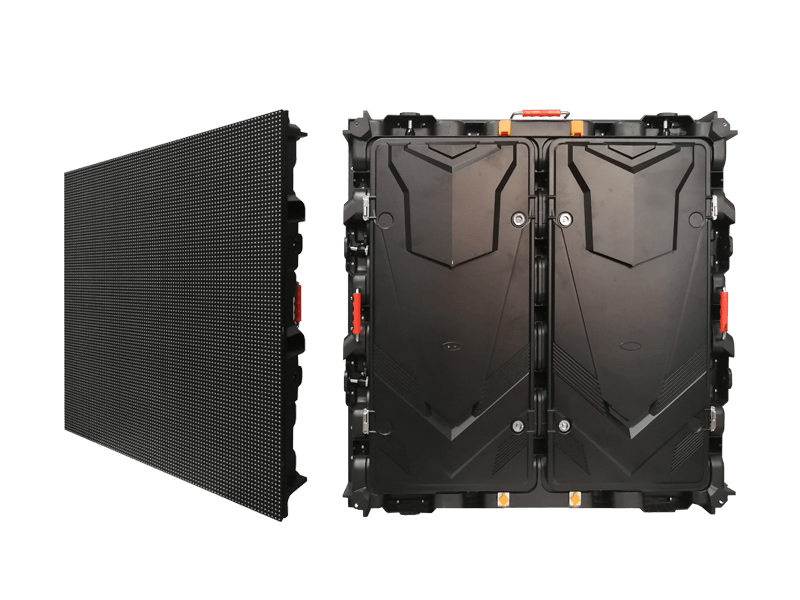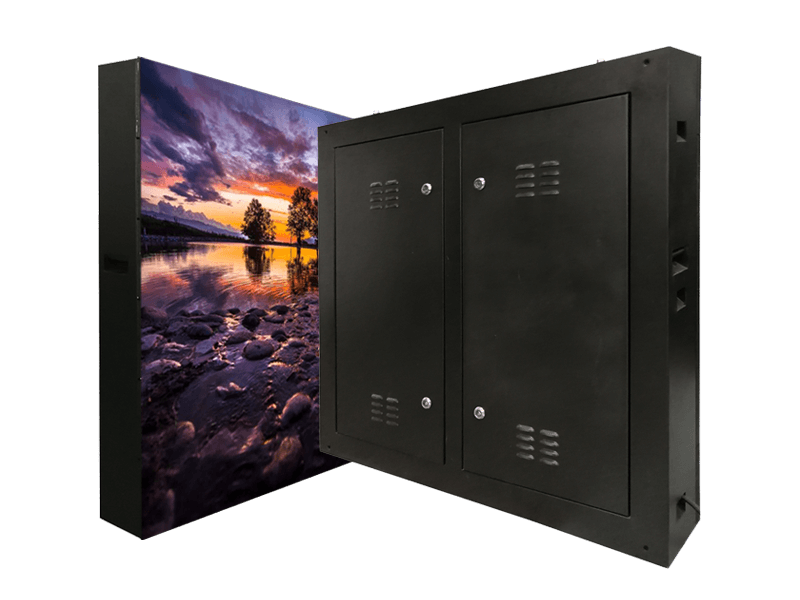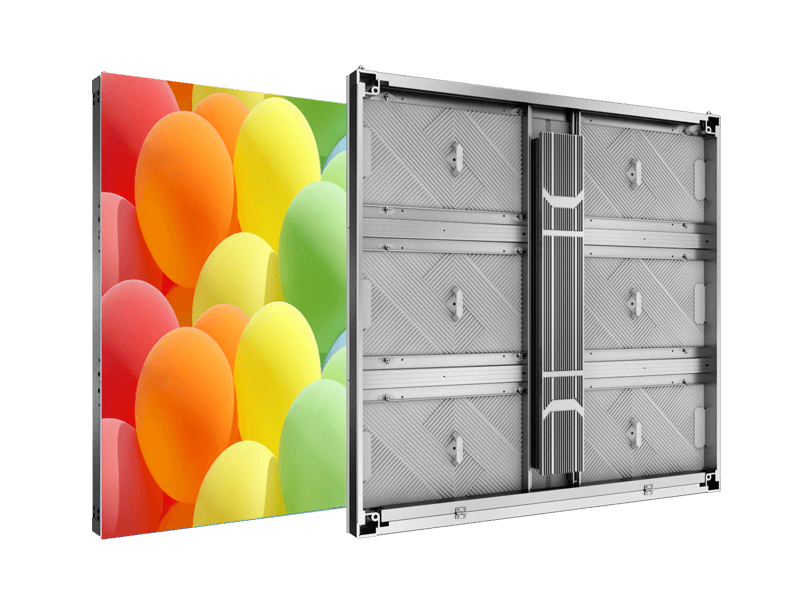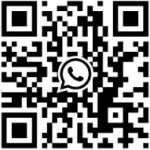3D LED Display
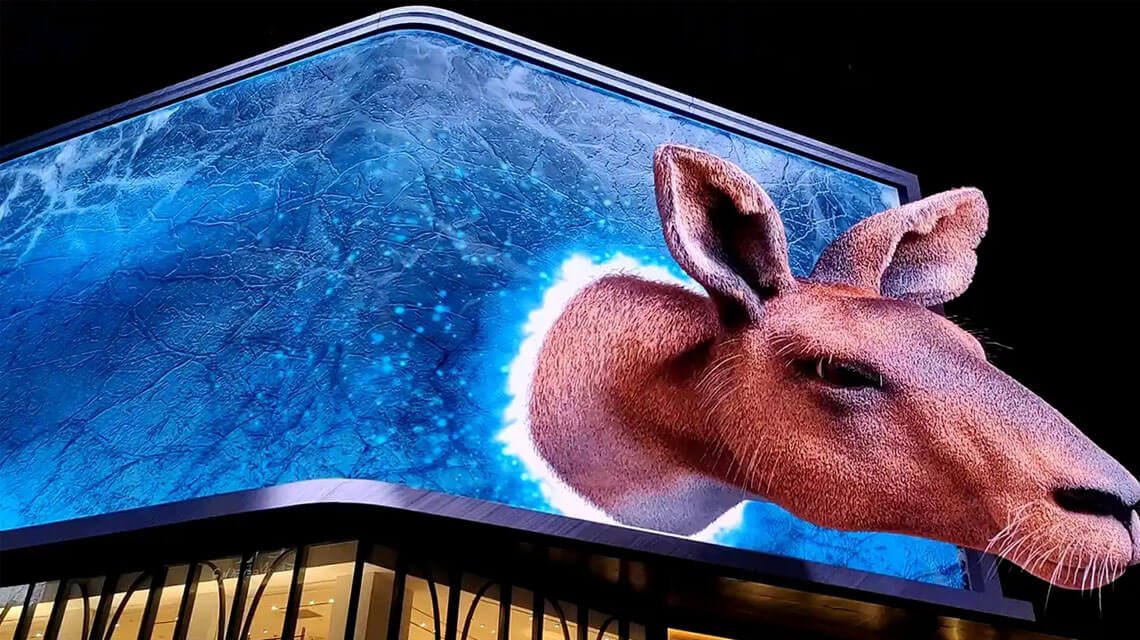
Hot Products for 3D LED Display Projects
Discover how 3D LED displays are transforming outdoor advertising and immersive experiences. Learn about technology, cost, applications, and Singheng’s solutions.
- Cabinet material: Magnesium
- Cabinet dimension: 960*960mm
- Refresh: 3840HZ
- Cabinet material: Magnesium
- Cabinet dimension: 960*960/customized
- Refresh: 3840HZ
- Cabinet material: Aluminum
- Cabinet dimension: 960*960mm
- Refresh: 3840HZ
Become a distributor? Or need a quote?
3D LED Display Solutions: The Ultimate Guide
Explore the most advanced 3D LED display technologies and learn how Singheng helps global clients deploy stunning, immersive LED solutions.
Key Takeaways
| Keyword: | 3D LED display |
| Main Benefit: | Stunning naked-eye 3D visuals without glasses |
| Applications: | Outdoor advertising, retail, architecture |
| Why Singheng: | 15+ years experience, OEM/ODM, global service |
1. Introduction
The world of digital signage has seen countless innovations over the past decade, but few have captured the imagination and public attention quite like 3D LED displays. These dazzling installations, blending high-resolution LED screen technology with specially created visual content, have turned ordinary building facades and city squares into viral sensations. From Seoul’s giant crashing waves to Chengdu’s floating spaceship, and the mesmerizing 3D tiger leaping out at Times Square in New York, 3D billboards have become a powerful new storytelling medium.
But these displays are more than just flashy graphics. They represent a leap forward in advertising, entertainment, brand engagement, and visual communication. With naked-eye 3D effects, they captivate audiences without the need for glasses, transforming passive viewers into engaged participants.
For businesses, governments, advertisers, and venue operators, 3D LED displays represent a tremendous opportunity to differentiate themselves, attract attention, and increase revenue. However, successfully creating a 3D display project involves much more than simply purchasing an LED screen. It requires specialized content creation, reasonable screen layout design, technical parameter planning, and a deep understanding and optimization of realism and visual impact.
In this comprehensive guide, we’ll explore the full world of 3D LED displays—from how they work and where to use them, to costs, product recommendations, and expert insights from Singheng, a leading LED screen manufacturer in China with 15+ years of industry experience.
Whether you're a city planner, marketing agency, retail brand, real estate developer, or LED distributor, this guide is your starting point to harness the magic of 3D LED screens and take your visual impact to the next level.
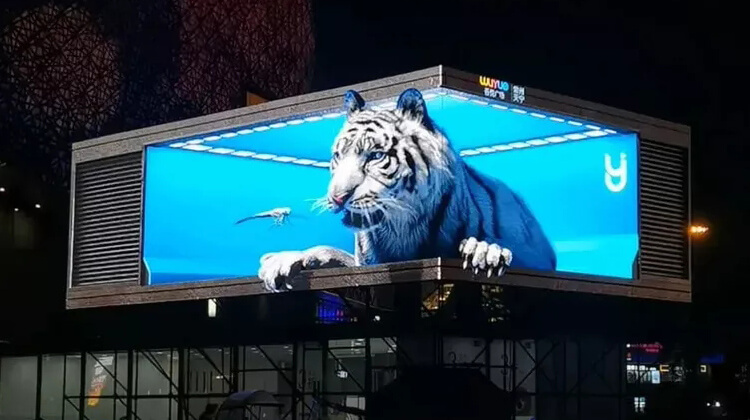
2. What Is a 3D LED Display?
A 3D LED display is a digital signage screen that creates the illusion of depth and spatial realism, often without the need for special glasses. This is typically achieved through a combination of:
- High-resolution LED screens
- Specially designed 3D video content
- Screen structures that enhance the three-dimensional effect (such as 90-degree corner installations)
What makes these displays stand out is their ability to fool the human eye into seeing lifelike animations that appear to leap off the screen or float in space. This is known as “naked-eye 3D.”
Unlike stereoscopic 3D (which requires glasses), naked-eye 3D relies on motion parallax, shading, lighting, and visual perspective to simulate depth. These techniques are cleverly used in content design to produce jaw-dropping effects.
These LED displays have gained viral popularity due to their ability to instantly grab attention and spread rapidly on social media. They're frequently used in:
- Outdoor advertising (DOOH)
- Retail storefronts
- Entertainment venues
- Corporate exhibition halls
- Public infrastructure
Essentially, 3D LED displays are still LED screens that play specially rendered video content. However, their resolution, brightness, contrast, and—most importantly—the physical design of the screen (flat, curved, or cornered) all impact how realistic the final visual experience is.
At Singheng, we specialize in producing both standard and customized 3D LED display solutions. Whether you're installing a curved façade, 90-degree corner billboard, or immersive display wall, our high-refresh, high-brightness screens are engineered for maximum realism and visual impact.
3. How 3D LED Displays Work
Essentially, 3D LED displays are still ordinary LED screens that display pre-rendered 3D content. However, their resolution, brightness, contrast, and especially the physical design of the screen (such as flat, curved, or cornered shapes) all affect the realism of the final 3D effect.
Singheng specializes in manufacturing both standard and custom 3D LED display solutions. Whether for curved facades, 90° corner screens, or flat installations, our high-brightness, high-refresh-rate LED panels combined with precision engineering deliver the hardware needed to support world-class 3D visuals.
3D LED display technology combines optics, LED screen design, and specially created visual content to simulate realistic depth and motion in a two-dimensional medium. There are two main types of 3D LED displays: glasses-based 3D and naked-eye 3D. Both rely on manipulating the viewer’s perception through precise image presentation and hardware capabilities.
3.1 Glasses-Based 3D LED Technology
In glasses-based 3D displays—commonly used in cinemas or virtual reality applications—the screen shows two separate sets of images simultaneously, one for each eye. The viewer wears active (shutter-based) or passive (polarized) 3D glasses that filter these images accordingly.
In the early days, shutter-based 3D technology was used in LED displays. The display rapidly switched between left and right eye images at an extremely high refresh rate (typically ≥3840Hz), while 3D glasses synchronized with the refresh signal to ensure that each eye saw the correct image in sequence.
This method:
- Retains native screen resolution
- Requires 3D-capable LED controller and video processor
- Delivers true 3D visuals but depends on viewers wearing glasses
This method is suitable for immersive experiences in controlled environments, but is not suitable for open public spaces and outdoor advertising. This technology has now been largely phased out in the LED display field.
3.2 Naked-Eye 3D LED Displays
Naked-eye 3D is what most people refer to when they talk about modern 3D LED billboards. These displays do not require any glasses or additional viewing devices. Instead, they rely on visual tricks including:
- Forced perspective
- Screen folding (e.g., 90° corner installations)
- Shading, light, and motion parallax
The video content is specifically rendered to match the physical screen shape and viewing angles. For example, a 90° corner LED display allows content to “wrap” around the corner, creating the illusion that a 3D object is protruding out into space.
Technically, this is still 2D video content shown on a 2D screen. The realism comes from how accurately the video simulates perspective from the viewer’s vantage point.
Success depends on:
- High-brightness, high-resolution LED panels
- Screen pixel pitch (fine pitch enhances realism)
- Content mapped precisely to the screen surface
Naked-eye 3D displays are ideal for outdoor advertising and public locations where viral visual impact is important.
3.3 Are 3D Billboards Truly 3D?
A common question is whether 3D LED displays are truly “3D.” The answer is: no, not in the physical sense. These are flat or curved 2D screens showing 2D content rendered to simulate 3D effects.
They do not create volumetric or holographic displays. However, when executed properly, the visual result is so convincing that it creates a strong illusion of three-dimensionality.
These types of billboards are gaining rapid popularity in cities around the world, especially in Asia, the U.S., and Europe. Their blend of eye-catching design, marketing power, and digital creativity makes them a new standard for high-impact DOOH (Digital Out-of-Home) advertising.
At Singheng, we provide the technical expertise, product hardware, and content development support to help clients deploy compelling 3D LED display projects. From curved cabinet solutions to pixel-level color calibration and 3D content rendering partnerships, we ensure the full system works harmoniously to deliver breathtaking results.
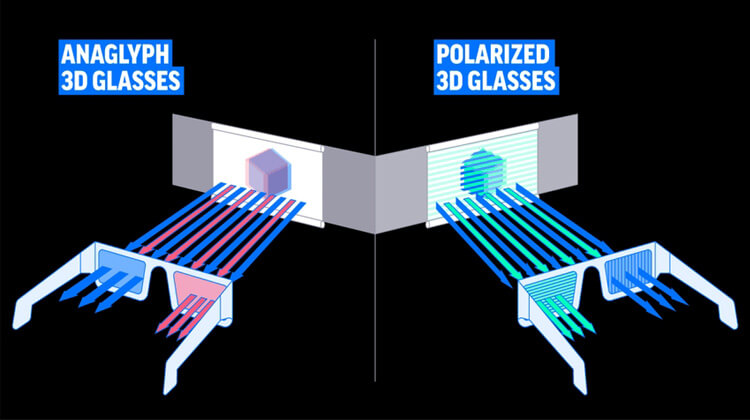
4. Cost of 3D LED Billboards
Many people wonder: how much does a 3D LED display really cost? The total investment includes both the hardware (LED screen itself) and the software (the 3D video content). Costs can vary widely depending on screen size, pixel pitch, brightness, shape (flat, curved, or corner), and installation environment.
Let’s break down the two main components of cost:
- LED Screen Hardware – the physical display panels, cabinets, structure, control systems
- 3D Content Creation – the design, animation, and rendering of realistic 3D videos
4.1 Cost of the 3D LED Display
The LED screen portion is calculated based on square meters and the specific product configuration. Key factors include:
(1) Pixel Pitch
Finer pitch (like P2.5, P3.91) means higher resolution and cost per square meter. Coarse pitch (like P10) is cheaper but less suitable for close-up 3D visuals.
(2) Display Size
Naturally, larger displays cost more overall but may benefit from lower per-square-meter rates.
(3) Shape
Flat screens are cheapest. 90° corner or curved designs require custom cabinets and angle-matching precision.
(4) Brightness
Outdoor screens need 4,000–6,000 nits brightness or higher, which increases LED and power costs.
(5) Protection Level
Outdoor 3D LED display screens must meet IP65 or higher waterproof and dustproof standards. This ensures longevity and stable performance, especially in harsh climates.
Estimated Cost Ranges:
- Small indoor 3D LED display: $5,000–$20,000
- Mid-sized 3D billboard (50–100㎡): $50,000–$100,000
- Large outdoor corner billboard: $150,000–$300,000+
Singheng’s FC21, FM296, and FA296 series offer energy-efficient, modular, and customizable options to reduce long-term costs while maintaining premium performance.
4.2 Cost of 3D Content Creation
(1) Video Complexity
The most critical cost driver in a 3D LED project is the content. Realistic, perspective-mapped 3D animations require detailed modeling, lighting, shading, and camera motion simulation.
Simple content may cost $1,000–$3,000. High-end, cinematic-quality visuals (like spacecraft flying out of a building) can cost $10,000–$50,000 depending on the length.
(2) Owner content insertion
If the owner needs to incorporate their own exclusive content into the video, such as their own products or specially designed storylines, the cost of 3D content production is very high. If the owner only needs generic 3D content, such as animals or flowing water, which does not have unique characteristics, the price is very low.
(3) Duration
Longer videos take more time to render and increase cost. Most clients choose looped videos of 15–45 seconds.
(4) Production Timeline
Urgent projects may incur rush charges. Standard production timelines range from 2–6 weeks depending on complexity.
(5) Studio and Equipment
Singheng partners with professional studios using software such as Unreal Engine, Cinema 4D, or Blender to produce visually stunning 3D content.
(6) Content Format and Mapping
Singheng provides mapping templates based on the physical screen structure. Final delivery is often in HAP, MP4, or MOV formats, optimized for playback on Novastar or Colorlight systems.
Summary of Total Investment
| Project Type | LED Screen Cost | Content Cost | Total Estimated Cost |
|---|---|---|---|
| Small Indoor (3–5㎡) | $5,000–$10,000 | $1,000–$3,000 | $6,000–$13,000 |
| Medium Outdoor (50㎡) | $40,000–$70,000 | $5,000–$10,000 | $45,000–$80,000 |
| Large Outdoor (100㎡+) | $100,000–$200,000 | $10,000–$30,000 | $110,000–$230,000 |
By combining LED screen supply, content mapping templates, and referral to 3D content partners, Singheng helps you manage your budget effectively and deliver maximum visual impact.
5. How 3D LED Billboards Increase Profits
In the competitive world of advertising and branding, visibility and memorability are critical. 3D LED billboards offer more than just flashy visuals—they deliver measurable business value. From viral marketing exposure to improved ROI, the financial and strategic advantages of 3D LED technology are significant.
5.1 Viral Marketing Impact
Brands that invest in 3D LED display billboards often see dramatic spikes in social media attention. These screens create memorable, cinematic moments that people film, share, and comment on—creating free viral exposure.
Examples include:
- Nike’s floating shoebox in Tokyo
- Coca-Cola’s 3D wave billboard in Times Square
- Chengdu’s spaceship display in China
These displays attract global attention and press coverage—without additional ad spend.
5.2 Visual Appeal
Unlike static billboards or flat LED panels, 3D LED displays instantly engage passersby. The illusion of depth, movement, and interaction holds the viewer’s gaze longer, improving ad recall and emotional impact.
Consumers are far more likely to remember brands that offer a novel or entertaining experience, which leads to higher brand equity and customer loyalty.
5.3 Public Attention and Engagement
3D LED display billboards act as physical landmarks. In high-traffic areas such as shopping malls, commercial zones, and entertainment districts, these screens create buzz and foot traffic. They become talking points, selfie spots, and crowd magnets.
Retailers and property developers can use this to:
- Increase walk-in rates
- Enhance location branding
- Attract premium tenants and sponsors
5.4 Revenue Potential and ROI
Investing in 3D LED display billboards may involve higher upfront costs than traditional displays, but the return on investment can be significantly higher. Here’s how:
- Increased ad rates: 3D screens command premium CPM rates.
- Sponsorship opportunities: Brands pay more to be featured in high-profile 3D activations.
- Multi-brand rotation: One screen can display 3D content for multiple advertisers.
- Higher occupancy: Locations with 3D screens attract better tenants and more events.
A Forbes study showed that immersive 3D content increases purchase intent and conversions for luxury brands by up to 40%.
At Singheng, we help you maximize your profits by providing not only cutting-edge 3D-capable LED displays, but also content consultation, screen mapping guidance, and hardware-software optimization. With our reliable, cost-efficient solutions, your 3D LED display billboard can become a long-term revenue-generating asset.
6. Popular Application Scenarios
3D LED displays are highly versatile and can be applied across multiple industries and environments. Their immersive visuals, coupled with high brightness and dynamic content, make them suitable for both indoor and outdoor use. Here are the top nine application scenarios:
(1) Shopping Malls and Media Facades
Large shopping centers and high-end malls use 3D LED walls as digital art installations and promotional displays. Curved or corner-wrapped LED screens can showcase product launches or seasonal themes in a dramatic way, increasing shopper dwell time and brand engagement.
(2) Retail Stores
Retail storefronts adopt smaller 3D LED displays to highlight new arrivals or promotions. These displays catch pedestrian attention and convert foot traffic into in-store visits. Luxury brands use them to deliver a modern, tech-savvy impression.
(3) Exhibitions and Trade Shows
3D LED booths at trade fairs attract significantly more visitors. Exhibitors use them to demonstrate product features, corporate capabilities, or brand vision in a way that’s far more impactful than posters or flat screens.
(4) Experience Centers and Museums
Exploration halls, museums, and science centers utilize 3D LED displays to create interactive learning environments. Whether it’s simulating natural phenomena or reconstructing historical events, 3D visuals make the educational experience immersive and memorable.
(5) Central Business Districts
In CBDs, 3D LED displays turn buildings into branding powerhouses. Financial institutions, real estate developers, and corporate offices use them for digital identity, investor updates, and public communication.
(6) Building Renovation and DOOH Advertising
Old buildings can be revitalized through facade-mounted 3D LED screens. These displays double as architectural elements and advertising tools, turning underused exteriors into revenue-generating digital real estate.
(7) Education and Training Facilities
Universities and corporate training centers leverage 3D displays for simulation-based learning. This includes medical training, engineering design, or environmental modeling. It’s an innovative tool for visualizing complex concepts.
(8) 3D LED Floor Screens
These screens can withstand weight and weather, making them perfect for interactive zones in theme parks, event spaces, or retail environments. With pressure sensors, they display different content based on foot traffic or user interaction.
(9) Virtual Production and Film Studios
Virtual production using XR + LED video walls is booming. 3D LED screens replace traditional green screens to offer real-time environments for filmmakers, reducing post-production and increasing on-set visualization. Compatible with Unreal Engine and camera tracking systems, Singheng’s displays support professional-level virtual production workflows.
With each of these scenarios, Singheng provides tailored hardware solutions, including FC21, FM296 and FA296 series screens, designed to handle unique structural and performance requirements. From high brightness and fine pitch to waterproof modules and energy-saving tech, Singheng helps turn vision into reality across industries.
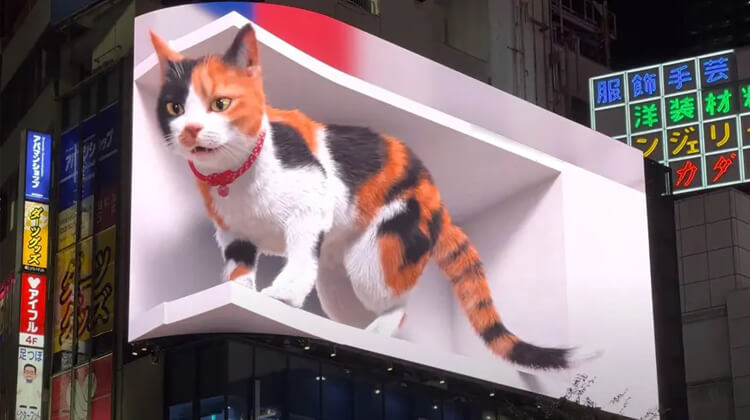
7. Standards for High-Quality 3D LED Displays
To deliver a compelling and immersive 3D experience, your LED screen must meet specific performance and design criteria. Here are seven key standards that define a high-quality 3D LED display:
(1) High Grayscale, High Refresh Rate, and High Contrast Ratio
A smooth and detailed 3D image relies on accurate color representation and dynamic range. Look for LED displays with:
- Grayscale of 14–16 bits
- Refresh rate ≥ 3840Hz
- Contrast ratio ≥ 5000:1
These specs ensure vibrant, flicker-free, and lifelike visual output—especially crucial when recording or displaying fast-moving 3D content.
(2) Proper Brightness and HDR Compatibility
Brightness levels of 6000–8000 nits are necessary for outdoor displays to remain visible under direct sunlight. Support for High Dynamic Range (HDR) improves contrast and delivers richer visuals.
Singheng’s FA296, FM296 and FC21 series both support HDR and maintain high brightness in all lighting conditions.
(3) Customized LED Cabinets and Structural Design
Standard flat panels cannot achieve realistic naked-eye 3D effects. Custom corner modules, 90° folding designs, and curved cabinets are essential. These allow for the proper perspective illusion.
Singheng provides customizable module sizes and cabinet shapes to meet architectural needs.
(4) Realistic Parallax through Video Mapping
The 3D illusion works only when content is precisely mapped to the physical structure of the LED screen. High-quality 3D displays require:
- Accurate measurement of angles and depth
- Perfect synchronization between content and structure
- Parallax-aware video rendering
Singheng supplies mapping templates and works with content creators to align visuals with LED layout.
(5) Seamless Integration with the Environment
To enhance visual impact, a 3D screen must blend into its environment. Consider:
- Ambient light compatibility
- Architectural symmetry
- Discreet installation of power/data lines
This creates a clean, immersive look that feels like part of the building rather than an add-on.
(6) Advanced Driving ICs and LED Chips
A high-performance 3D LED display requires robust electronics. Choose displays that use:
- PWM driving ICs from brands like ICN or MBI
- Energy-efficient, high-brightness LED chips
- Redundant circuitry for reliability
Singheng sources top-tier components and performs strict quality control on each batch.
(7) Long-Term Stability and Low Maintenance
A premium 3D LED display must remain reliable through years of operation. Key features include:
- IP65/IP66 waterproof and dustproof protection
- Heat dissipation structure for thermal stability
- Easy front/rear maintenance options
Singheng’s products come with 3-year warranties, remote tech support, and optional GOB protection for enhanced durability.
By ensuring your display meets these seven standards, you can create stunning naked-eye 3D effects that are both technically sound and visually breathtaking.
By ensuring your display meets these seven standards, you can create stunning naked-eye 3D effects that are both technically sound and visually breathtaking.
8. Hot Products for 3D LED Projects
At Singheng, we’ve developed advanced LED products that are fully compatible with naked-eye 3D visual applications. Among these, three standout product series—FC21, FM296, and FA296—are particularly optimized for creating immersive and high-impact 3D effects.
8.1 FC21 Series – Outdoor 3D LED Display
The FC21 series is specially engineered for outdoor naked-eye 3D billboards with 90° folding corner structures. Designed to withstand harsh environments while delivering visual excellence, it is an ideal choice for commercial city displays and landmark advertising.
Key Features:
- 90° seamless cabinet splicing for right-angle 3D display construction
- High brightness: 5000–6500 nits for visibility under direct sunlight
- Front and rear maintenance options
- IP65-rated waterproof and dustproof design
- Compatible with pixel pitches: P2 /P2.5 /P3 /P4 / P5 / P6.6 / P8 / P10
- Supports HDR and 3840Hz high refresh rate
Application Scenarios:
- Building facades
- Outdoor commercial plazas
- High-traffic intersections
- Landmark media zones
With its modular structure and optional curved interface customization, the FC21 ensures outstanding image consistency and structural stability—perfect for large-scale installations.
8.2 FA296 Series – Versatile Indoor/Outdoor Display
The FA296 series is a robust, all-purpose LED display solution that can be used both indoors and outdoors. Its lightweight and flexible configuration make it well-suited for small to mid-sized 3D projects that require high definition and ease of use.
Key Features:
- Cabinet size: 960mm × 960mm (standardized)
- Supports pixel pitches: P4.4 /P5.7 / P6.67 / P8 / P10
- High contrast ratio of 5000:1
- IP66 waterproof rating
- Supports front and rear maintenance
- Optional energy-saving solution
- Tool-free quick module and power box replacement
Application Scenarios:
- Retail stores and brand flagship facades
- Shopping malls
The FA296 is easy to install and maintain, making it a cost-effective option for clients looking to enter the 3D LED display market without compromising on performance or reliability.
8.3 FM296 Series – High-End Outdoor Performance
FM296 is designed for premium outdoor 3D displays with ultra-high brightness, strong contrast, and wide viewing angles. Suitable for demanding visual effects in sunlit environments, this series ensures your content looks sharp day or night.
Key Features:
- Up to 8000 nits brightness
- Pixel pitches available: P2 / P2.5 / P3 / P4 /P5 / P6.67 / P8 / P10
- Optional common cathode technology for power savings
- Magnesium alloy structure for excellent heat dissipation
Its performance and durability make the FM296 ideal for long-term outdoor 3D applications in high-profile urban zones.
8.4 Why Choose Singheng for Your 3D Project?
- 12+ years of manufacturing excellence
- Global project experience with high-profile clients
- Customized cabinet and module design
- Technical guidance for 3D video mapping and optimization
- Dedicated after-sales support, remote assistance, and spare parts backup
- Competitive pricing from factory-direct supply
Whether you're planning a massive city-center landmark or a retail upgrade, Singheng’s FC21, FM296 and FA296 series offer scalable, high-performance, and fully 3D-compatible LED display solutions.
9. Singheng's Advantages and Solutions
Singheng operates two manufacturing bases in Shenzhen and Dongguan, totaling over 20,000 square meters. From LED module production to cabinet assembly and aging tests, every product undergoes strict quality inspections to ensure optimal performance and durability.
- ISO-certified processes
- 3-year standard warranty
- Module-level aging and calibration
- Customization support from PCB to cabinet
9.1 Expert 3D Project Consultation
We understand that 3D LED display projects are not just about hardware—they’re about creating an immersive visual experience. That’s why Singheng provides pre-sale consultation, engineering evaluation, and design optimization tailored to each project.
- Site analysis and screen layout design
- Perspective rendering consultation
- 3D video production technical support
- Electrical and structural schematics for installation
9.2 3D Video Content Assistance
For naked-eye 3D displays, content creation is half the success. Singheng cooperates with experienced animation studios to offer high-impact custom 3D content and provide mapping templates based on screen angles and structures.
- Content rendering optimization
- Multi-format compatibility (HAP, MP4, MOV)
- Support for parallax correction and geometric calibration
9.3 Global Logistics and Remote Support
Singheng ships globally and supports projects in over 80 countries. Our logistics and support systems are designed to simplify the LED display deployment process.
- Real-time order tracking
- Spare parts supply chain
- 24/7 multilingual technical support via remote connection
- Installation guidance and operation training
9.4 Comprehensive Product Line
From flexible LED screens and LED posters to rental, transparent, and all-in-one conference displays, Singheng offers a broad range of products—all customizable for 3D display compatibility. This makes us a one-stop solution provider for various industries and applications.
- Indoor & outdoor fixed LED displays
- 3D LED floor screens
- Transparent & curtain-type displays
- Rental solutions for events and exhibitions
9.5 Partnership and Distributor Opportunities
We are currently expanding our global network of partners and distributors. Singheng offers strong back-end support, marketing materials, and competitive pricing to help partners grow in their local markets.
- OEM/ODM services
- Regional protection policies
- Training, co-branding, and joint promotions
- After-sales service package
Whether you're a brand looking for a landmark 3D installation or a distributor searching for reliable LED supply from China, Singheng delivers expertise, hardware, and support from concept to completion.
10. Conclusion
As 3D LED display technology continues to revolutionize visual communication, it is transforming how brands connect with their audiences across the globe. From outdoor advertising landmarks to immersive retail experiences and interactive installations, 3D LED displays are unlocking new dimensions of engagement and branding.
Through this comprehensive guide, we’ve explored everything from the fundamentals of 3D LED displays and their working principles to cost structures, application scenarios, and performance benchmarks. We’ve also showcased how Singheng’s product lines—especially the FC21, FM296 and FA296 series—are uniquely suited for delivering high-impact 3D projects around the world.
Whether you are a business owner seeking to attract foot traffic, an integrator planning a 3D display project, or a distributor aiming to expand your LED product portfolio, Singheng is your reliable partner.
We believe in more than just selling screens—we deliver visual solutions that work, inspire, and convert.
Ready to Bring Your 3D Vision to Life?
Let Singheng help you turn any wall, corner, or façade into a stunning 3D digital landmark.
🌐 Visit: https://www.singhengled.com
📩 Contact: Contact Us
11. FAQ
Q1: What is a 3D LED Display?
A: A 3D LED display is a digital screen that creates the illusion of three-dimensional visuals, often without the need for glasses. Using content designed with perspective and depth, it tricks the viewer’s eyes into seeing realistic, pop-out effects.
Q2: Do I need special glasses to view 3D LED displays?
A: No. Most 3D LED displays today are naked-eye 3D, meaning you don’t need glasses. They rely on video perspective design and display curvature to create a 3D effect.
Q3: What screen size is recommended for 3D displays?
A: For impactful naked-eye 3D effects, outdoor screens of 100㎡+ are ideal. Indoor 3D installations work well at 3–20㎡, depending on pixel pitch and viewing distance.
Q4: How much does a 3D LED screen cost?
A: Cost depends on size, resolution, pixel pitch, brightness, waterproofing, and content production. Small projects start from $5,000–$30,000, while large outdoor billboards can exceed $200,000.
Q5: Can I use a 2D screen to display 3D visuals?
A: Yes. Most 3D LED billboards are technically 2D screens. The 3D effect is created through custom video content and screen layout (e.g., 90° corners).
Q6: What content format is needed for 3D playback?
A: Singheng recommends HAP, MP4, or MOV formats, designed based on the actual screen dimensions and angle. Content must be mapped precisely to the LED layout.
Q7: Can Singheng help with video content creation?
A: Yes. Singheng offers technical guidance, mapping templates, and partners with professional 3D content studios to assist clients with high-impact visuals.
Q8: How long is the warranty for Singheng products?
A: Standard warranty is 3 years, with optional extensions. We also provide spare modules, power supplies, and remote tech support.
Q9: What industries are using 3D LED displays?
A: Retail, real estate, entertainment, tourism, transportation, education, public broadcasting, and even film production.
Q10: How do I get started with a 3D LED project?
A: Contact Singheng’s expert team for a free consultation at https://www.singhengled.com/contact-us. We’ll assess your site, budget, and goals to offer a customized 3D display solution.

